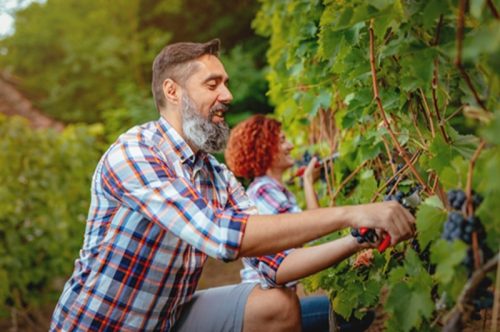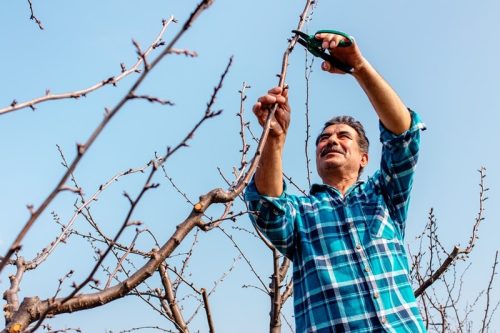Vine pruning requires patience, precision and understanding. Indeed, the way you prune your vines can have a significant impact on the health of the plant, the quantity of harvest you get and, above all, the quality of your grapes.
It’s an important step in the process of growing healthy, tasty grapes. Whether you’re a seasoned winemaker or a passionate amateur, understanding the fundamentals of vine pruning is essential to achieving an abundant, high-quality harvest.
In this article, we’ll explore the different pruning techniques and the right times to carry them out. Our advice will help you to prune your vines successfully and maximize the potential of your grapes.

Why prune a vine
Vine pruning is an essential step in vineyard management and plays a crucial role in the production of quality grapes.
- Growth control: vines tend to produce large quantities of wood, branches and shoots every year. Pruning helps to control this excessive growth by eliminating unnecessary parts, thus helping the plant to concentrate its energy on the buds that bear the grapes.
- Encourage regeneration: by removing branches and shoots from the previous year, pruning encourages the growth of new buds and shoots. These new shoots are more vigorous and often bear bunches of grapes.
- Optimizing production: pruning adjusts the vine’s load, i.e. the number of bunches it can support. Reducing the number of bunches per vine encourages better ripening of the grapes, leading to higher-quality grapes.
- Vine training: pruning is also used to shape the vine according to the desired growing method, such as Guyot or cordon de Royat. This allows specific control of vine growth to maximize quality and ease of management.
- Disease prevention: by removing diseased or damaged parts of the vine, pruning helps reduce the risk of spreading disease and infection.
When and how to prune:
Vine pruning is a crucial operation that must be carried out with care to guarantee an abundant, high-quality harvest.
Training pruning
Training pruning is one of the fundamental stages in vine cultivation, especially when creating a new vine or when you want to give a young vine a specific shape. It aims to establish the vine’s basic structure by encouraging the growth of the main branches while limiting the number of branches.
Size objective
- Establishing the shape: the main objective is to define the structure of the vine according to the chosen method of cultivation (e.g. cordon, goblet, espalier). This will determine how the vine will develop in the future.
- Promoting balanced growth: by reducing the number of shoots and branches, training pruning encourages more balanced vine growth. This limits competition for resources between different parts of the plant.
Pruning method
The method of training pruning varies according to the desired vine shape. For example:
- Cordon de Royat: for this method, you select one or more side branches (cordons) on the main trunk, spacing them evenly along the trunk. The buds of future fruiting shoots are selected from these cords.
- Goblet: with the goblet, you encourage several carpenter branches to grow around the trunk, forming a goblet-shaped structure.
- Espalier: if you opt for an espalier method, you guide the branches horizontally along a support, usually a trellis or wall.
Training pruning is generally carried out during the vine's first few years, just after the first winter.
Fruiting pruning
The aim of fruiting pruning is to shape the vine in such a way as to encourage an abundant, high-quality harvest by limiting the number of grape bunches and stimulating the growth of new, productive shoots.
Size objective
- Distribution of resources: by limiting the number of bunches of grapes, fruiting pruning enables the vine to concentrate its resources on a reduced number of fruits, thus favoring their ripening and quality.
- Stimulation of growth: by cutting off excess branches and shoots, pruning encourages the vine to produce new shoots and branches, often bearing bunches of grapes.

Pruning method
- Cordon: we select the buds on the cordon that will give rise to new productive shoots. Excess shoots and unnecessary parts are also removed.
- Goblet: we select the most suitable carpenter branches, generally located at a certain height from the ground, and eliminate undesirable branches and twigs that will not contribute to grape production.
- Espalier: for vines grown in espaliers along a horizontal support, the branches are guided along this support. Pruning for fruiting involves selecting and maintaining the main branches, as well as eliminating non-productive parts.
Fruiting pruning is generally carried out at the end of the second year of growth, at the start of the third spring, 1 or 2 years before the plant is fully formed between July and September.
Green pruning
Green pruning is an important practice for optimizing harvest quality by promoting better aeration, exposure to sunlight and concentration of resources on the grape bunches.
Green pruning objective
- Growth control: green pruning limits excessive vine growth, which can prevent the vines from becoming too dense, thus promoting better air circulation and exposure to the sun.
- Improved quality: by adjusting foliage density and eliminating unwanted shoots, green pruning helps concentrate resources on the grape bunches, which can improve fruit quality.
- Disease prevention: a well-ventilated vineyard exposed to the sun is less likely to develop fungal diseases, as humidity is reduced, helping to keep vines healthy.

Pruning method
-
Goblet: for a goblet-grown vine, green pruning may involve eliminating excessive shoots growing inside the goblet, obstructing air and light circulation. Foliage density can also be adjusted by removing certain leaves to allow better light penetration and reduce the risk of mildew.
-
Cordon de Royat: in the case of a Royat cordon vine, green pruning consists of eliminating unwanted shoots growing along the cordon, adjusting the density of foliage to promote air circulation and thinning out overly dense areas for better exposure to the sun.
-
Espalier: for espalier vines, green pruning can include eliminating shoots that grow too close to the trellis or wall and adjusting foliage density for better ventilation.
Green pruning is a viticultural operation carried out during the vine's growing season, generally in spring or early summer.

